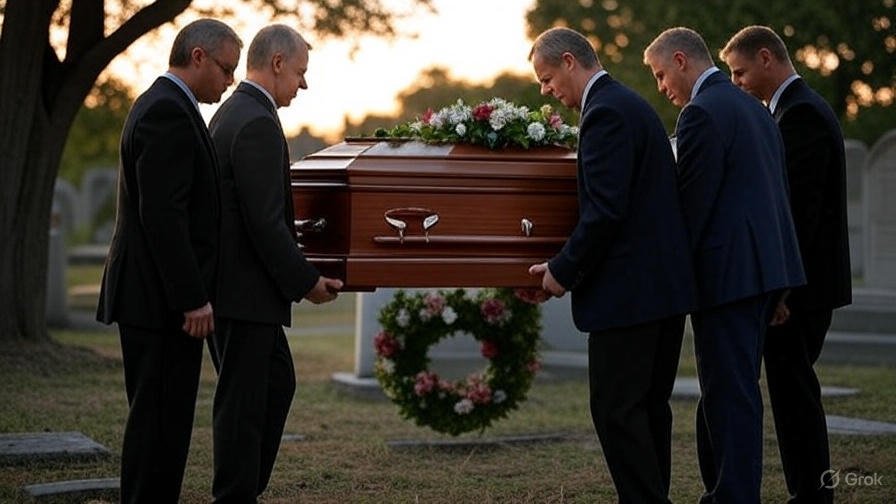In a pallbearer funeral, chosen individuals carry or escort the casket, showing deep respect. This role blends history with modern practices. The National Funeral Directors Association notes pallbearers feature in over 60% of U.S. traditional funerals. This article explores their duties, trends, and tips for families.
What Is a Pallbearer Funeral?
A pallbearer funeral involves family or friends carrying or escorting the casket during the service. This task holds both practical and emotional value. Pallbearers lead the procession from the hearse to the venue or gravesite, setting a respectful tone.
Historical Roots of the Pallbearer Funeral
The pallbearer funeral began with early Christian customs, using a ‘pall’ cloth over the casket. Community members carried it as a sign of honor. The Cremation Association of North America highlights Victorian-era choices based on social status.
Modern Trends Shaping Pallbearer Funerals
The pallbearer funera adapts to today’s needs. Recent trends include diverse participants and personalized touches. Here are key changes:
- Inclusive Roles: Women and youth now serve as pallbearers, breaking old norms.
- Personalized Tributes: Pallbearers wear matching items or add cultural rituals.
- Virtual Participation: They join livestreams, escorting caskets on-screen.
- Eco-Friendly Options: Lighter caskets ease the physical load.
These updates keep the pallbeare funeral relevant and meaningful.
Practical Tips for Choosing and Supporting Pallbearers
Selecting pallbearers requires care. Follow these tips for a smooth pallbeare funeral:
- Choose Based on Connection: Pick people close to the deceased.
- Check Physical Ability: Ensure they can carry the casket or use aids.
- Give Clear Instructions: Funeral directors guide on timing and positioning.
- Offer Support: Provide emotional help if needed.
The Funeral Consumers Alliance suggests training sessions to boost confidence. This preparation ensures dignity.
Cultural Variations in Pallbearer Funeral Practices
The pallbearer funeral varies by culture. Each tradition adds unique elements:
- Christian Funerals: Pallbearers carry the casket with hymns.
- Jewish Traditions: They escort simply, avoiding excess.
- African American Communities: Processions feature music and dance.
- Asian Funerals: Rituals include specific directions or incense.
These differences enrich the pallbeare funeral globally.
The Emotional Significance of Being a Pallbearer
Being a pallbearer offers a chance to honor the deceased. It brings closure but also emotional challenges. Families often see it as a final gift. Support options help pallbearers cope with grief.
The Grief.com community shares stories of pride mixed with sorrow. This role fosters support during tough times.
The Future of Pallbearer FuneraL
The pallbearer funera will evolve further. Cremations lead to urn escorts, and eco-friendly caskets grow popular. Technology may add virtual roles.
The International Cemetery, Cremation and Funeral Association predicts these changes will balance tradition and innovation.
Frequently Asked Questions About Pallbearer Funeral
How many pallbearers are needed?
Usually 6-8 carry a casket, but fewer work for lighter loads.
Can women serve as pallbearers?
Yes, women increasingly join, reflecting inclusivity.
What should pallbearers wear?
Formal attire, often matching the funeral theme, works best.
Is training provided?
Yes, funeral homes offer brief training for safety.
Conclusion
The pallbearer funeral remains a powerful way to honor loved ones. It blends history with modern practices. Families can plan thoughtfully using resources like the National Funeral Directors Association. This ensures a dignified farewell.


